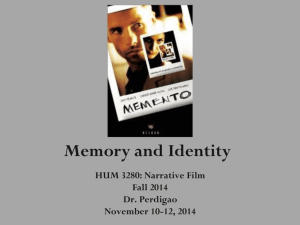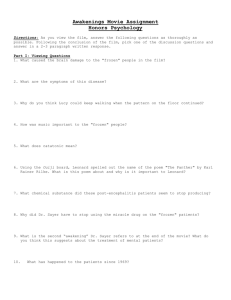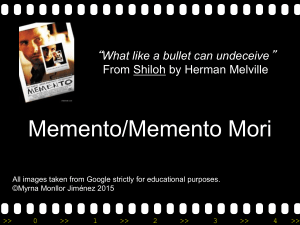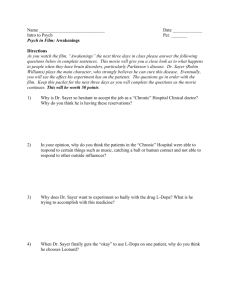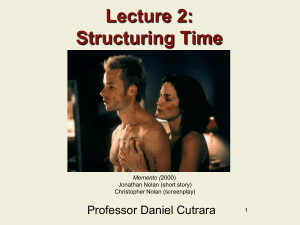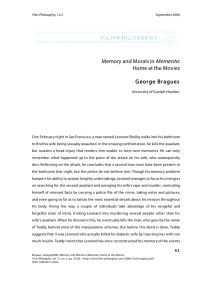File
advertisement
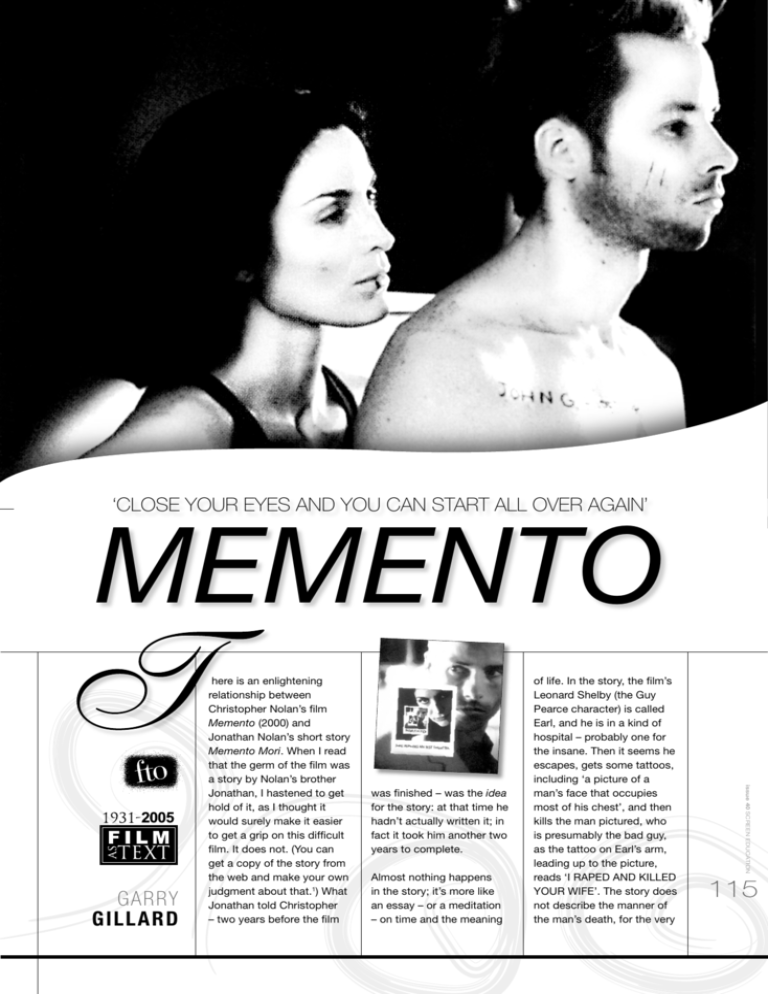
‘close your eyes and you can start all over again’ memento was finished – was the idea for the story: at that time he hadn’t actually written it; in fact it took him another two years to complete. Almost nothing happens in the story; it’s more like an essay – or a meditation – on time and the meaning of life. In the story, the film’s Leonard Shelby (the Guy Pearce character) is called Earl, and he is in a kind of hospital – probably one for the insane. Then it seems he escapes, gets some tattoos, including ‘a picture of a man’s face that occupies most of his chest’, and then kills the man pictured, who is presumably the bad guy, as the tattoo on Earl’s arm, leading up to the picture, reads ‘I RAPED AND KILLED YOUR WIFE’. The story does not describe the manner of the man’s death, for the very issue 40 SCREEN EDUCATION G a r ry G i l l a rd here is an enlightening relationship between Christopher Nolan’s film Memento (2000) and Jonathan Nolan’s short story Memento Mori. When I read that the germ of the film was a story by Nolan’s brother Jonathan, I hastened to get hold of it, as I thought it would surely make it easier to get a grip on this difficult film. It does not. (You can get a copy of the story from the web and make your own judgment about that.1) What Jonathan told Christopher – two years before the film 115 good reason that it is mostly narrated from Earl’s point of view, and by the time he is being driven away from the scene of the murder he has already forgotten what happened. What the two narratives have in common – and it is Jonathan’s main contribution to Christopher’s project, together with the basic revenge motive and the story’s use of tattoos – is that both Leonard and Earl have a short-term memory problem called ‘anterograde memory loss’, which means that, having had a traumatic injury, they cannot make any new memories. One of the functions of the web site www.otnemem.com (which was designed by Jonathan, and yes, that’s ‘memento’ backwards) is to increase the degree of commonality between the two stories. It is based on documents: newspaper reports, police documents, and notes written by Leonard to himself – and it provides a different backstory for Leonard. In the version on the web, he has been a patient interned in an institution (like Earl), and escapes and kills someone. L issue 40 SCREEN EDUCATION 116 eonard’s institutionalization creeps into the film in a most striking moment – unless you blink and miss it. In Chapter 40 on the DVD, entitled ‘final exam’, Sammy Jankis is in an institution after having killed his wife by overdosing her with insulin. The camera looks at Sammy sitting in the ward for some seconds until a doctor walks by in front of him. Cut to the same scene – except now it’s Leonard who is sitting in the same chair! The duration of the shot is less than a second. There are three possible readings of this shocking moment. Christopher Nolan may be simply playing with the audience, and the shot may be what David Bordwell would call ‘artistically motivated’. You can also read the scene as indicating where Leonard ends up, or, more satisfactorily, where he has been (as in Jonathan Nolan’s story and web page). This last interpretation is best, as it ties in with what Teddy tells Leonard not long before the latter kills him (in the long Chapter 42, ‘Revenge meeting’). Teddy reveals (and I read this as being the version of events that we are meant to take as the ‘right’ one – I’ll try to justify this in a moment) that Sammy Jankis was an insurance fraud, that he had no wife, and that it was Leonard himself whose wife had diabetes, and that he killed her with an overdose of insulin in the way that we have been ‘shown’ that Sammy killed Mrs Jankis. And we see ‘flashbacks’ of Leonard doing just that. Although this is not in the story as told by the film, we might like to imagine that Leonard was incarcerated after his wife’s death (as shown in the half-second flash in Chapter 40) and that he escaped (as suggested by the web site) to get his revenge. The notion of ‘revenge’ provides one of the keys to approaching this film in generic terms. In an interview to be found on the web, the director has this to say, in a delightfully informal but informative way, about the use of this story type. ... it’s this notion of what is revenge, it doesn’t have any value outside of somebody’s head. And this is the perfect story for exploring that. What’s interesting to me is you introduce the beautiful wife that he has the fond memories of, and in so many movies it’s like which reel is she going to die in. Then the hero is allowed to go out and commit otherwise morally questionable acts, but the filmmaker plays this little balancing game with the relative moral values in the movie, so it’s OK for the hero to go out and kick ass.2 The idea of revenge not only allows filmmakers to play with ‘relative moral values’, it also provides a very useful structure for the narrative. There is a clear goal, with a powerful psychological motivation, but there are also many opportunities for suspense, as the hero has to overcome a number of obstacles to carry out his task, and it will probably take at least ninety minutes to recount them all. A nother conventional structure used by the film is the crime film genre and its detective subset. In this type of plot, the central character is an investigator (whether a professional one or not) and their goal is to solve the crime, usually a murder. It’s quite a common trope for this investigator not to be a police officer and for them to be smarter than the cops, although they may work partly with them. In Memento, of course, Leonard is the investigator, and the task he has set himself to carry out is to find his wife’s killer. Revenge will be the icing on the cake of detection. The brilliant twists in Nolan’s take on this structure are manifold. If you take Teddy’s final revelations, as mentioned above, as the ‘correct’ version, then it turns out that Leonard himself is the murderer. However, note that in the same scene Teddy himself gives different versions of other events. First he says Jimmy Grantz, whom Leonard has just killed, was the man who raped Catherine. But when Leonard raises the question of the two hundred grand in Jimmy’s car, and it’s clear that a drug deal of some kind has been arranged between Teddy and Jimmy, Teddy shifts his ground. He tells Leonard that he, Leonard, has killed the actual perpetrator quite some time ago: I was the cop assigned to your wife’s case. I believed you. I thought you deserved a chance for revenge. I’m the one that helped you find that guy in your bathroom that night, the guy that cracked your skull and raped your wife. We found him; you killed him. As if he had not provided enough clever variations on the detection/revenge structure, Nolan provides one final piece of brilliant invention. He has Leonard note Teddy’s licence plate number, and then erase the evidence that supports memento the present situation and Teddy’s account of what led up to it. He destroys two photos: the one of the dead Jimmy Grantz, and the other of himself covered in blood, which Teddy says he took just after Leonard killed the real John G, the original perpetrator. He then goes to record the last piece in the jigsaw – to get the tattoo of Teddy’s plate number – and as he drives towards Emma’s Tattoos he forgets, of course, what he has just done. This will allow him to conclude, as we saw him do back in Chapter 5 ‘Just the Facts’, that Teddy (John Gammell) is the right John G, and the one who has to be killed – which is the first thing we see in the film. I believe that Memento must be unique in one aspect of its structure, in that the very first thing we see after the film’s title appears on the screen is the very last thing that occurs in the story. Many other films begin with the same situation as the one with which they end. Sunset Boulevard (Billy Wilder, 1950) is one well-known example. The film opens with the William Holden character lying face down in the swimming pool; the twist in the story is that it is he who narrates the film in voice-over, despite being ‘already dead’. But Wilder’s film begins, as usual, running forwards. The outrageous thing about Nolan’s is that his is actually running backwards. at the Jimmy photo record developing, the two strands come together, and the remainder of the film is in colour. Audiences may not become aware of this immediately. Under some of the opening credits we see a Polaroid photo of what looks like the body of man who has been shot; but in a short space of time the photo inexplicably fades. It may be only when the gun that Leonard Shelby throws away flies into actor Guy Pearce’s hand that we realize the film is being projected backwards. So the first moment is the last. It is also possible to see Christopher’s film coming together with Jonathan’s short story. As Leonard is driving away to get his last tattoo, he seems to have a moment of epiphany. He closes his eyes and we hear his voice-over: Another Polaroid is used at another key structural moment, in Chapter 42, called ‘Revenge Meeting’ on the DVD inlay. After Leonard kills Jimmy, he takes a photo of him lying on the floor of the basement, minus the suit that Leonard has stolen and put on himself. As the Polaroid photo develops, the black and white film that we are watching turns to colour. Until this point in the movie, the sequences shown in colour have been shown in the reverse order to which they occur in the story, while the shorter black and white sections have been proceeding in the ‘normal’ order of chronology. At this point, as the camera looks I have to believe in a world outside my own mind. I have to believe that my actions still have meaning. Even if I can’t remember them. I have to believe that when my eyes are closed the world’s still there. In the short story, Earl tells himself: Time is three things for most people, but for you, for us, just one. A singularity. One moment. This moment. Like you’re the center of the clock, the axis on which the hands turn. Time moves about you but never moves you. It has lost its ability to affect you. What is it they say? That time is theft? But not for you. Close your eyes and you can start all over again. Conjure up that necessary emotion, fresh as roses. they are both the result of meditation on the nature of experience, the nature of time, and the relationship between the two. If you think about the film as a noir thriller presenting ‘morally questionable acts’ and ‘relative moral values’, which it is and does, you’ll miss much of the point. Blade Runner (Ridley Scott, 1982) is that kind of film too, but Roy the replicant’s lament for the moments of his life that will be ‘lost in time, like tears in the rain’ is one of the finest meditations on memory, meaning and time that I can recall in any medium. Memento is memorable too. Garry Gillard teaches Australian Cinema at Murdoch University. • Endnotes 1 See www.impulsenine. com/homepage/pages/ shortstories/memento_ mori.htm Accessed 27 Aug 2004. If you have the Region 1 DVD, it’s also on that, but it’s not on the Region 4 disc I used to research this article. 2 See www.filmthreat. com/Interviews. asp?File=InterviewsOne. inc&Id=136 Accessed 27 August 2004. These two insights are not quite the same, but www.theeducationshop.com.au issue 40 SCREEN EDUCATION ATOM Education Shop: A practical, valuable and exciting source of articles for teachers and students 117
